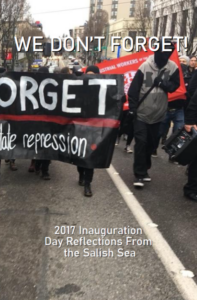Enfant Terrible
A San Francisco Anarchist Periodical, 1891
Click here for our zine on Clara’s life, incorporating the text below.
Title _ Vol.-No. _ Day Month Year
Enfant Terrible 1-3 8 Nov 1891
Enfant Terrible 1-6 20 Dec 1891
Clara Dixon
Poet-Printer of Early American Anarchism
Download Clara Dixon: Poet-Printer of Early American Anarchism Letter-imposed printing
 Before the internet wove its globe-spanning web of social media, far-flung groups and individuals were brought together via the print culture of books, pamphlets, newspapers, and journals. The revolutionary culture of the anarchist movement was, in many respects, incubated in the pages of its printed matter. Letters to ones favorite paper often engaged in discourse with one another, bringing correspondents from San Francisco to South Africa to the same playing field. The rapid proliferation and decreasing cost of such publications thus provided more than just a passive window through which to view the world, opening up a new intellectual and social universe.
Before the internet wove its globe-spanning web of social media, far-flung groups and individuals were brought together via the print culture of books, pamphlets, newspapers, and journals. The revolutionary culture of the anarchist movement was, in many respects, incubated in the pages of its printed matter. Letters to ones favorite paper often engaged in discourse with one another, bringing correspondents from San Francisco to South Africa to the same playing field. The rapid proliferation and decreasing cost of such publications thus provided more than just a passive window through which to view the world, opening up a new intellectual and social universe.
As deeply-entrenched patriarchal norms pushed late-nineteenth women into the “private sphere,” anarchist print culture offered an outlet for those determined to make their voice heard. When scanning the pages of periodicals like The Alarm or Free Society, the femme presence is impossible to ignore. Letters to the editor frequently appear from small-town readers connected to the wider world through their favorite subversive publication. Women also played vital roles in creating and sustaining anarchist publications, as editors and typesetters, as authors and distributors.
Clara Dixon exemplified this literary radicalism. For years she developed her Anarchist politic while living in small-town Iowa coal and farming country. Clara wrote short stories, articles, and most of all poetry for submission to papers across the country. Eventually she took an even bigger leap; at nearly 40 years old she left Iowa alone for San Francisco. Now immersed in a growing anarchist milieu, Clara went on to edit two anarchist newspapers and later write a novel with strong sapphic themes. She also took a particular interest in anti-authoritarian relations between parents and children.
Please enjoy this brief journey through Clara Dixon’s radical life.
____________________
Clarissa “Clara” Dixon was born November 30, 1851 in the small town of Hennepin, Illinois. At a young age her family moved to another small town in Iowa’s farming and coal belt: Amityville. Her “Scotch-Irish” family had early-colonial settler roots and were strict religious fundamentalists. Her parents even taught their children “a roundabout route to school to keep them from passing the house or a reputed atheist.
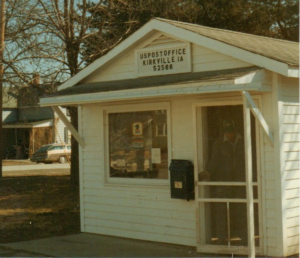 But when she turned 17 (the age of confirmation in her church), Clara instead “stood up and announced that, having lost her belief in the tenants of the church, she was renouncing her membership.
But when she turned 17 (the age of confirmation in her church), Clara instead “stood up and announced that, having lost her belief in the tenants of the church, she was renouncing her membership.
She sensibly left town,” moving to the nearby towns of Eddyville and Kirkville, where she would spend more than two decades. Within a couple years of leaving home, Clara had married George Davidson and the two had a son Clarence.
Clara did not intend to become a quiet housewife.
She hustled through school classes in nearby Ottumwa, eventually taking college courses. Clara became one of the few schoolteachers in her local area and also became a prolific writer.
Clarence later recalled happy memories of his childhood, painting a “warm and loving domestic scene in which Geroge treated Clarissa with tenderness.” The couple’s finances were handled jointly. But all was not marital bliss: they briefly separated after a year of marriage because “she refused to submit to sexual relations, which she found distasteful.” She also later claimed to have found her husband’s business practiced unethical. Nevertheless the couple remained together for twenty years.
Through her writing and poetry, Clara’s mental horizon expanded far beyond little Kirkville. She became a frequent contributor to a wide variety of reform and later radically minded newspapers. Papers like the Chicago Sentinel, New Thought, The Christian Socialist, and the Iowa Farmer’s Tribune circulated widely but frequently relied on volunteer contributions to fill their pages. Eventually she even utilized a toy typesetting device to produce her own radical leaflet.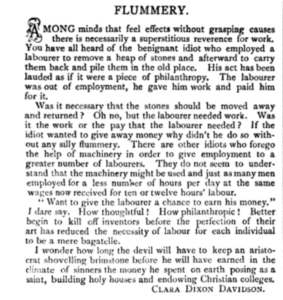
It should be noted that at least one of these early poems betrayed the settler-colonial mentality all-too common in white radicals then and often now. The Oklahoma War-Chief sought to bring about its demands of ”restoration of the public domain, lands for the landless and homes for the homeless, Universal Suffrage, and a national currency issued by the federal government” through the settlement of the Oklahoma (aka “Indian”) territory, preceding the infamous Oklahoma “Land Rushes” by several years.
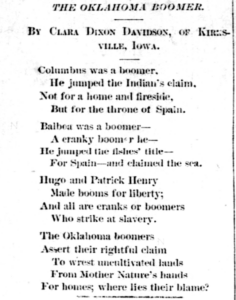 Clara’s poem put a bottom-up spin on the issue, seemingly arguing that settler’s were even more justified in making claims than conquistadors had been; the latter did so on behalf of a crown, the former to find land for homes.
Clara’s poem put a bottom-up spin on the issue, seemingly arguing that settler’s were even more justified in making claims than conquistadors had been; the latter did so on behalf of a crown, the former to find land for homes.
Clara Dixon Davidson’s radical reading and writing eventually led her to correspondence with anarchist and socialist papers. During the mid-1880s, two parallel organizations claimed to carry-on the torch of the “International Workingman’s Association,” the “First International.” The explicitly anarchist “Black” International Working People’s Association was rooted in the midwest and northeast, its most famous adherants organizing in Chicago. The self-described “Red” international, the “International Workman’s Association” meanwhile, was headquartered in San Francisco with significant participation as far East as Colorado and Kansas.
 In 1884, letters and poems from Clara appear in Chicago’s Alarm, the English weekly of the “Black” IWPA, as well as the main organs of the IWA, Denver’s Labor Enquirer and San Francisco Truth. By this time Clara clearly counted herself in the radical camp, ending a treatise in the Enquirer advocating for men and women to organize with the famous call:
In 1884, letters and poems from Clara appear in Chicago’s Alarm, the English weekly of the “Black” IWPA, as well as the main organs of the IWA, Denver’s Labor Enquirer and San Francisco Truth. By this time Clara clearly counted herself in the radical camp, ending a treatise in the Enquirer advocating for men and women to organize with the famous call:
“Workingpeople of the world, unite; you have only your chains to lose, you have a world to win.”
Both Internationals loudly called for organizing and direct action to overthrow the capitalist system, by dynamite if necessary. But unity between these two bodies was not to be.
The staunchly decentralized organization of the Black IWPA, privileging local group autonomy, did not mesh easily with the San Francisco body’s call for a tightly centralized, albeit secretive, pyramid structure. Many in the two groups nevertheless believed they fought towards the same ends and as 1885 rolled into 1886, discussions about merging were top of the agenda.
The wrench in these plans was forged from a tremendously important question of principle: was “The International” open to all, regardless of race or nationality? Both organizations paid affirmative lip-service, but the anarchistic IWPA took it far more seriously, even as many of its members waffled on the premise.
The two Internationals took up parallel campaigns of escalation, focusing on issues they hoped could convert popular outrage into social revolution. For the anarchists in the East, this was the struggle for the “Eight Hour Day.” The western Red International planted its feet on much grimmer ground: expelling the Chinese laborers many white settlers felt undermined their standards of living and ability to organize. Many IWPA anarchists were shamefully willing to overlook this as a minor disagreement, or worse sympathized with the drive. But enough viewed this as an obvious betrayal of their global emancipatory vision to effectively halt merger talks.
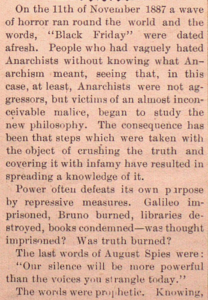 In May, 1886, hundreds of thousands struck demanding the Eight Hour Day across much of the United States. IWPA sections played a significant agitational role in the uprising that witnessed intense clashes between strikers and armed state forces. Most infamously, police murdered several workers outside the McCormick harvester factory in Chicago. Local anarchists responded by calling a mass-meeting at “The Haymarket.”
In May, 1886, hundreds of thousands struck demanding the Eight Hour Day across much of the United States. IWPA sections played a significant agitational role in the uprising that witnessed intense clashes between strikers and armed state forces. Most infamously, police murdered several workers outside the McCormick harvester factory in Chicago. Local anarchists responded by calling a mass-meeting at “The Haymarket.”
Cops ordered the rally disperse, someone threw a bomb, and the cops responded with gunfire. Seven anarchists were sentenced to death afterwards, including the chief-editors of Chicago’s anarchist papers. Four were hanged, one killed himself before the state could.
State Repression following the 1886 strike wave was intense, and not just in Chicago. Politicians, business owners, and mainstream newspaper publishers railed against anarchism, which they argued was a foreign subversion bordering on insanity. Yet Clara argued that ‘Repression Breeds Resistance,’ channeling Haymarket martyr August Spies final declaration that “our silence will be more powerful than the voices you strangle today.” A whole new wave of radicals awoke to the immense injustice in society following what many argued was a politicized frameup trial. Among these were a new generation of radical poets and publishers, like Emma Goldman and Voltairine de Cleyre.
Temporally parallel to the Eight Hour agitation was a brutal wave of anti-Chinese pogroms in the far-west. Entire Chinese communities were driven out of towns like Eureka, California and Tacoma, Washington. Dozens if not hundreds of Chinese people were massacred. At the forefront of this agitation was the “Red” IWA of San Francisco, whose members hoped to “convert the anti-Chinese storm into an anti-Capital storm” not by diverting attention but by riding full-speed ahead.
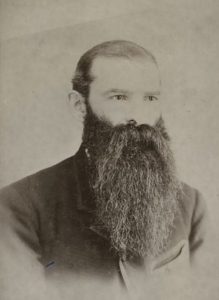 One of the very few opponents was Sigismund Danielewicz, a tireless traveling organizer. Sigismund was the Red International’s Secretary until he spoke out against the anti-Chinese violence, calling for a move to higher principles.
One of the very few opponents was Sigismund Danielewicz, a tireless traveling organizer. Sigismund was the Red International’s Secretary until he spoke out against the anti-Chinese violence, calling for a move to higher principles.
A few years later, he launched a new anarchist paper in San Diego and later San Francisco: The Beacon. The paper drew readers and contributors from both the old networks around the Chicago Alarm as well as his own contacts on the West Coast, becoming a vital bridge between the anarchism of the Haymarket period and that of later years.
Clara first became a semi-regular contributor to The Beacon while still living in distant Kirksville.
In 1890, Clara’s twenty-year marriage to George Davidson ended in an apparently amicable separation and later divorce. Their son already lived on his own. Determined to escape the “stifling atmosphere of rural Midwestern fundamentalism,” Clara set off alone on a train for San Francisco at the age of 39.
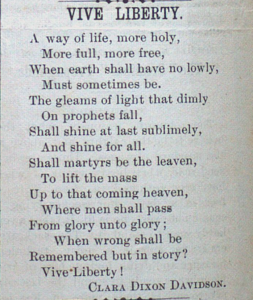 Clara was drawn to San Francisco’s bohemian literary milieu, and her articles and poems from the following decades appear frequently in publications from the Overland Monthly to The Nation. But Clara didn’t rely solely on the good grace of other editors to publish her work.
Clara was drawn to San Francisco’s bohemian literary milieu, and her articles and poems from the following decades appear frequently in publications from the Overland Monthly to The Nation. But Clara didn’t rely solely on the good grace of other editors to publish her work.
In 1891, she joined Sigismund Danielewicz as The Beacon’s assistant editor. Under their guidance the paper notably spoke out for the rights of San Francisco’s Chinese residents, unique among the San Francisco radical press in a time where trade unions explicitly advertised their products being made with “white labor.”
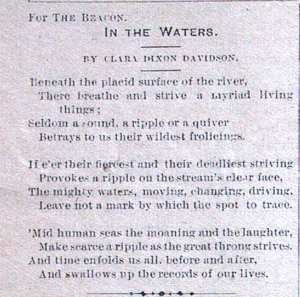
Not long after Clara joined The Beacon’s staff, Sigismund stepped down from his post and turned over the paper’s type, printing equipment, and subscription list to her. Perhaps reflecting the differences in their sentiments, she chose to rename the paper. Clara teamed up with her new boo, the Irish Anarchist immigrant Harry (H.C.B.) Cowell to edit Enfant Terrible. Sigismund remained an advocate for dynamite politics long after the Haymarket tragedy; Clara called for a more “evolutionary” than “rev-olutionary” trans-formation, privileging education and cultivation of individual freedom over insurrection.
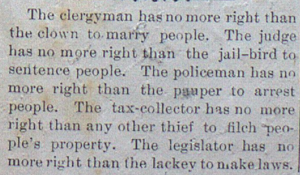 Both surviving issues of Enfant Terrible lead with a poem by Clara before alternating between long sections written by Clara and Harry. Reading from a 21st century vantage it comes off almost like a radical couples blog. Short fables and clever little anecdotes provoke little mental challenges to authority or expose societal hypocrisy. Brief commentary on current events like a proposed law closing business on Sunday reveals Clara and Henry’s distaste for intertwined capital, government, and organized religion.
Both surviving issues of Enfant Terrible lead with a poem by Clara before alternating between long sections written by Clara and Harry. Reading from a 21st century vantage it comes off almost like a radical couples blog. Short fables and clever little anecdotes provoke little mental challenges to authority or expose societal hypocrisy. Brief commentary on current events like a proposed law closing business on Sunday reveals Clara and Henry’s distaste for intertwined capital, government, and organized religion.
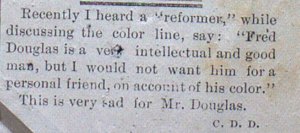 Enfant Terrible was relatively short-lived, its last available issue on December 20, 1891 was only the 6th. The February issue of another local individualist anarchist paper, Egoism, announced its cessation and that subscribers would receive their paper. Egoism’s May issue noted the couple’s participation in debates at the “People’s Free Lyceum” over the meaning of “Philosophical Anarchy.” Henry argued that “majority rule is inexpedient and a social failure because it defeats equal freedom, whereupon it follows that Anarchism is the correct social principle.” Clara delivered her own “sharp hits.”
Enfant Terrible was relatively short-lived, its last available issue on December 20, 1891 was only the 6th. The February issue of another local individualist anarchist paper, Egoism, announced its cessation and that subscribers would receive their paper. Egoism’s May issue noted the couple’s participation in debates at the “People’s Free Lyceum” over the meaning of “Philosophical Anarchy.” Henry argued that “majority rule is inexpedient and a social failure because it defeats equal freedom, whereupon it follows that Anarchism is the correct social principle.” Clara delivered her own “sharp hits.”
Enfant Terrible was relatively short-lived, but its free-love-minded editors remained together for another decade.
In February, 1893 the literary pair married and Clara took Cowell’s name.
In an 1893 article to the Boston anarchist paper Liberty, Clara outlined her vision for the relationship between parents and their children which, she thought, ought to resemble friend and friend rather than master and slave. Rather than notions of duty compelling either to care for the other, she felt that such relations ought to be rooted in love and a desire for social harmony, arguing that “generally speaking, people’s love for their children is in inverse proportion to their love of God and duty.” When it came to education, children deserved truthful, complete explanations for their many questions. Clara’s meditations on childraising did not remain a matter of hindsight:
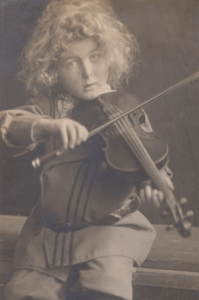 Henry Dixon Cowell was born March 11, 1897; Clara was 46 years old.
Henry Dixon Cowell was born March 11, 1897; Clara was 46 years old.
Henry Cowell was raised amid his parent’s San Francisco bohemian writers crowd. At a young age he was gifted a quarter-size violin and developed a lifelong commitment to music that led to a career as a renowned avant-garde composer. But at the age of six, Harry and Clara divorced so that Harry could marry another woman. Clara would take custody of their child, and would instill in young Henry a “philosophical anarchist principle of mutual aid and non-competition that he took seriously as long as he lived.” For several years they lived near San Francisco’s Chinatown, close to friends of his mother like the anarchist Anna Strunsky.
Clara encouraged her son’s musical career, and also apparently supported him during a youthful gender-bending phase in which he refused to wear trousers and insisted on being called “Mrs. Jones.” After Henry suffered both illness and severe bullying at school, Clara took it upon herself to homeschool him.
Life for the young mother and child was not always easy.
A small child-support payment from Harry was not enough to live on; Clara relied on her writing to make ends barely meet. She sold poems and stories to various literary magazines. After the 1906 San Francisco earthquake and fire destroyed most of their possessions, the pair briefly lived with Clara’s midwestern relatives before trying their luck in New York City.
1909 Clara published her lone novel: Janet & Her Dear Phebe.
Janet & her Dear Phebe tells the in-tense, emotionally charged tale of a loving relationship between two girls in a small Iowa town.
Separated in their teen-age years, they never gave up seeking contact and eventually re-united as adults. The novel might be dismissed as merely depicting an unusually intense Victorian friendship between two gal-pals, but what today might be called “queer” was hardly unknown in the Clara and her son’s bohemian circles. In 1936 Henry, who thought of himself as bisexual, would in fact be convicted of having oral sex with a young man and served four years in San Quentin.
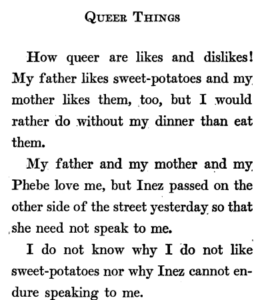
Janet unfortunately sold poorly, and Clara’s publisher declined her future books. In 1910 she and Henry returned to a small cottage in the then-young exurb of Menlo Park, near the campus of Stanford University. In these surroundings, Henry first achieved notice for his musical talents, while Clara met the final love of her life.
Ellen Veblen was newly divorced from the notable anti-capitalist Standford economist Thorstein Veblen. Clara later recalled that upon meeting Ellen at the home of a mutual friend around 1912:
“As soon as Mrs. Veblen had opened her mouth and spoken a few words, I knew that I was not too old for another love.”
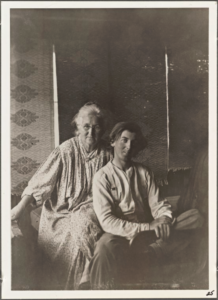 Ellen entered into a tight relationship with the mother-son duo, moving them into her house and later making Henry something of an adopted son and executor of her will. She also helped Henry make musical connections and afford a Steinway piano.
Ellen entered into a tight relationship with the mother-son duo, moving them into her house and later making Henry something of an adopted son and executor of her will. She also helped Henry make musical connections and afford a Steinway piano.
Tragically, Clara had only a few years to witness the growth of her son’s musical career and spend time with her new close “friend.” What she thought was tuburculosis turned out to be breast cancer.
Clara Dixon died May 15, 1916. She was 64.
Her last writing included an extensive memoir of her son’s early years.
Sources
Digitized issues of The Beacon can be found on our site at https://historicalseditions.noblogs.org/post/2022/04/15/the-beacon-digitized/
Scans were obtained with the gracious assistance of the International Institute for Social History in Amsterdam. We have also digitized other regional Anarchist periodicals and maintains an extensive list of digitized papers.
Clippings in this zine came from the following issues:
The Beacon: 5/3/1890, 3/28/1891
Enfant Terrible: 11/8/1891, 12/20/1891
Historical Seditions is also circulating the preliminary edition of an extensive Zine covering the often dark history of the San Francisco International Workman’s Association entitled Deconstructing Settler Socialism: The Internationals and Early Anarchism in the Wild West. We have not posted a PDF online, but it is available through a number of Anarchist book stores and we will gladly send in response to inquiries to historicalseditions@riseup.net
Clippings from other radical papers include the Denver Labor Enquirer (9/13/1884), Chicago Alarm (11/1/1884), San Francisco Truth (3/22/1884, Nov-Dec 1884), The Christian Socialist (2/1885), Boston Liberty (9/3/1892) and The Oklahoma War-Chief (7/23/1885)
Most second-hand quotes on Clara’s life were drawn two biographies of her son, Joel Sach’s Henry Cowell: A Man Made of Music and Michael Hicks’ Henry Cowell: Bohemian.
Janet & Her Dear Phebe can be found at frogpeak.org/dixon/index.html
Click here for our zine on Clara’s life, incorporating the text above.









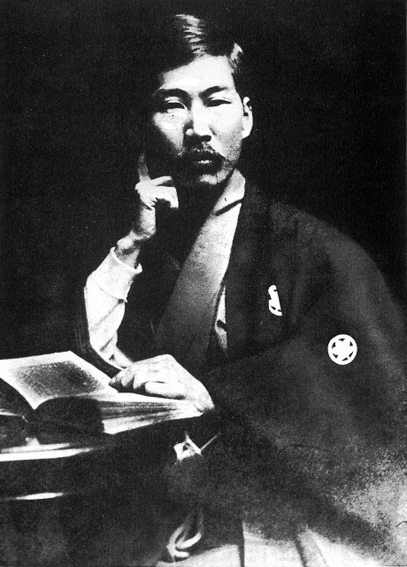
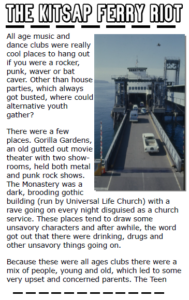 The Kitsap Ferry Riot tells the story of the restrictive old Seattle Teen Dance Ordinance and a punk riot that occurred on the ferry from Bremerton as a result. The text is pulled from the defunct website of a documentary about the riot by Chris Loomey,
The Kitsap Ferry Riot tells the story of the restrictive old Seattle Teen Dance Ordinance and a punk riot that occurred on the ferry from Bremerton as a result. The text is pulled from the defunct website of a documentary about the riot by Chris Loomey, 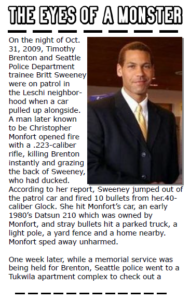 The Eyes of a Monster is the tale of Chris Monfort. Appalled by police brutality in his community, Chris looked the monster in the eye and refused to blink. He launched a one-man war against Seattle Police in 2009, bombing vehicles and killing one SPD officer in an ambush. Chris mysteriously died in Walla Walla State Penitentiary in 2017. (3 sheets letter)
The Eyes of a Monster is the tale of Chris Monfort. Appalled by police brutality in his community, Chris looked the monster in the eye and refused to blink. He launched a one-man war against Seattle Police in 2009, bombing vehicles and killing one SPD officer in an ambush. Chris mysteriously died in Walla Walla State Penitentiary in 2017. (3 sheets letter)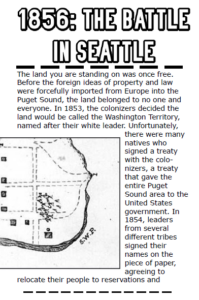 1856: The Battle in Seattle is the tale of Chief Leschi, the Nisqually, and other warriors who fought to expel the settler-colonial leviathan in its infancy. (2 sheets letter)
1856: The Battle in Seattle is the tale of Chief Leschi, the Nisqually, and other warriors who fought to expel the settler-colonial leviathan in its infancy. (2 sheets letter)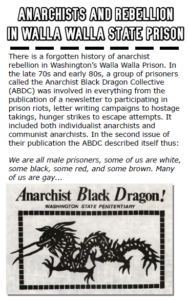 Anarchists and Rebellion in Walla Walla State Prison is an account of the Anarchist Black Dragon, an imprisoned anarchist collective who published an underground newspaper and helped spur several prisoner uprisings. (1 sheet letter)
Anarchists and Rebellion in Walla Walla State Prison is an account of the Anarchist Black Dragon, an imprisoned anarchist collective who published an underground newspaper and helped spur several prisoner uprisings. (1 sheet letter)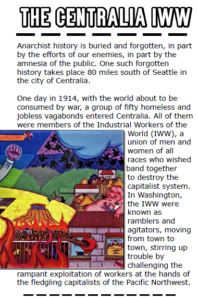 The Centralia IWW tells of the lumberjacks and hobos who organized a revolutionary union in this small Washington town. The intense repression they faced culminated in the so-called Centralia Tragedy in 1919. (2 sheets letter)
The Centralia IWW tells of the lumberjacks and hobos who organized a revolutionary union in this small Washington town. The intense repression they faced culminated in the so-called Centralia Tragedy in 1919. (2 sheets letter) The Dude Smashed the Federal Courthouse, Too! recalls the nationwide uprising in 1970 over the trial of Black Panther Bobby Seale and the Chicago Seven. The rowdiest solidarity action occurred in Seattle, where the federal courthouse was smashed. One of the most famous arrestees was Jeff Dowd, inspiration for “The Dude” in “The Big Lebowski” (1 sheet letter)
The Dude Smashed the Federal Courthouse, Too! recalls the nationwide uprising in 1970 over the trial of Black Panther Bobby Seale and the Chicago Seven. The rowdiest solidarity action occurred in Seattle, where the federal courthouse was smashed. One of the most famous arrestees was Jeff Dowd, inspiration for “The Dude” in “The Big Lebowski” (1 sheet letter)
